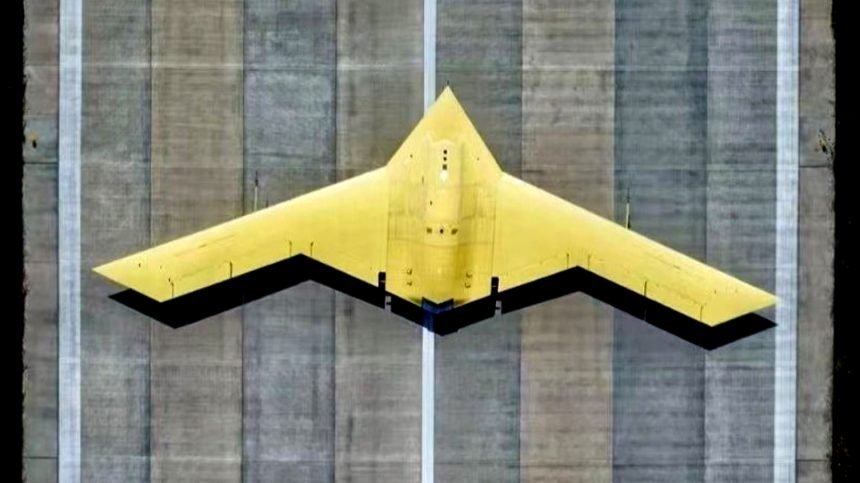What You Need to Know: At the Zhuhai Air Show, China unveiled its CH-7, a high-altitude, long-endurance stealth drone developed by the China Aerospace Science and Technology Corporation (CASC). Designed for intelligence, surveillance, and reconnaissance (ISR) and strike missions, the CH-7 is stealth-equipped, making it difficult to detect.
-This UCAV (Unmanned Combat Aerial Vehicle) poses a formidable challenge, especially if deployed in swarms, potentially destabilizing the Indo-Pacific region.
-With a cranked-kite wing design and internal weapons bay, the CH-7 marks a significant step in China’s defense capabilities, showcasing the country’s growing technological sophistication in drone warfare.
China Bets Big on Drone Warfare Capabilities with Their CH-7 Stealth Drone
The ongoing Zhuhai Air Show in Guangdong Province, China, is shaping up to be an historic display of Chinese technological capabilities and a sign of just how serious the Chinese military threat is to the United States.
During Deng Xiaoping’s time as leader of China, he crafted the 24-Character Strategy which advised future Chinese leaders to “Bide their time and hide their capabilities.” Under Xi Jinping’s rule, those days are long over. China is coming out for the world to see—and it has put the United States on notice: your days as the world’s sole remaining Superpower are coming to an end.
From revelations involving China’s answer to America’s fifth-generation multirole fighter, the F-35 Lightning II, the J-35, to rumors about the H-20 Xi’an long-range strategic stealth bomber being ready to fly “tomorrow,”China is letting the world know it is not messing around. Another interesting piece of technology that has been unveiled at the air show is the CH-7, a high-altitude, long-endurance unmanned combat aerial vehicle (UCAV) developed by the state-owned China Aerospace Science and Technology Corporation (CASC).
A History of Drones
Since the outbreak of America’s Global War on Terror (GWoT), unmanned drones have increasingly defined the world’s war zones. Drones have played a decisive role in the ongoing Ukraine War. China’s CH-7 stealth UCAV is designed for intelligence, surveillance, and reconnaissance (ISR) missions as well as strikes against targets deep within enemy territory.
And, with its stealth features, the CH-7 is meant to do all these mission sets without ever being detected.
The interesting thing about the CH-7 is its stealth. As noted above, the Ukraine War has highlighted the severe threat that increasingly sophisticated unmanned drones pose to more conventional forces on the battlefield. In Ukraine, non-stealthy drones have been most effective against tanks. Think about that: little first-person view (FPV) drones that cost a fraction of what a Main Battle Tank (MBT) have completely upended conventional tactics with armor.
A New, Stealthier Dimension
Stealth drones will now add an entirely new dimension. Given China’s massive advantages with industrial manufacturing, they will likely have swarms of these CH-7s within a few years that will completely complicate the ability of China’s enemies, like Taiwan, to defend themselves.
It is truly a destabilizing element in the annals of Indo-Pacific region warfare. And should China decide to export these systems to their partners (normally nations that are at odds with the Americans), it could become a globally destabilizing platform.
The Specs on the CH-7 Stealth Drone
Little in the way of technical details have been released by the usually opaque Chinese government. What can be gleaned from online sources is that the drone is slated be about 32 feet long, with a wingspan of 85 feet. Military observers believe that the CH-7 has a take-off weight of 22,046 pounds, and a maximum speed of 575 miles per hour. It can also stay aloft for approximately 15 hours.
Based on images that the Chinese military has allowed to be proliferated across Chinese media, the drone appears to have a cranked-kite wing design, flat exhaust, and sharper canted wingtips. A single turbofan engine powers the craft. The bird has an internal weapons bay to cut down on its radar cross-section (thereby enhancing its stealth).
Chinese state media (so, take from that what you will) reported in 2022 that the CH-7 could carry “huge missiles,” too.
The Next Several Decades
Drones will continue to fundamentally upend the warzones of the world, especially when married with capabilities like artificial intelligence (AI), and eventually quantum computing. Do not underestimate that which the Chinese have achieved as merely being puffery on the part of China’s military.
Of course, that’s at play here, as well. But China has turned a corner technologically. And should these technologies be called into combat; they will likely surprise the Americans and their allies at how effective they are.
About the Author:
Brandon J. Weichert, a National Interest national security analyst, is a former Congressional staffer and geopolitical analyst who is a contributor at The Washington Times, the Asia Times, and The-Pipeline. He is the author of Winning Space: How America Remains a Superpower, Biohacked: China’s Race to Control Life, and The Shadow War: Iran’s Quest for Supremacy. His next book, A Disaster of Our Own Making: How the West Lost Ukraine, is available for purchase wherever books are sold. Weichert can be followed via Twitter @WeTheBrandon.
Image Credit: Main image is from Chinese social media. All others images are from Creative Commons.
